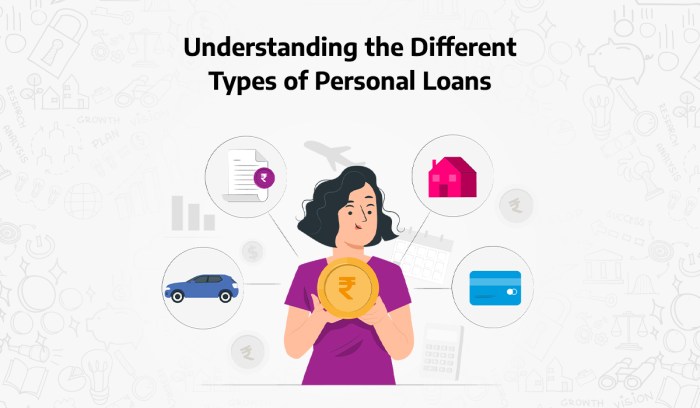Yo, listen up! Understanding personal loans is like navigating the halls of high school – full of twists and turns, but with the right knowledge, you’ll ace the test. Get ready to dive into the world of personal loans and come out with a fresh perspective that’s as cool as your favorite playlist.
Now, let’s break it down and learn everything you need to know about personal loans.
What are Personal Loans?

Personal loans are a type of loan that individuals can borrow from a financial institution, such as a bank or credit union, for personal use. These loans are typically unsecured, meaning they do not require collateral like a car or home loan.
Key Features of Personal Loans
Personal loans often come with the following features:
- Fixed Interest Rates: Personal loans usually have fixed interest rates, meaning the rate remains the same throughout the life of the loan.
- Repayment Terms: Borrowers can choose from various repayment terms, typically ranging from one to seven years.
- Loan Amounts: Personal loans can range from a few hundred to tens of thousands of dollars, depending on the borrower’s creditworthiness.
Common Purposes for Personal Loans
People often use personal loans for:
- Debt Consolidation: Combining multiple debts into one loan with a lower interest rate.
- Home Renovations: Funding home improvement projects or repairs.
- Emergency Expenses: Covering unexpected costs like medical bills or car repairs.
- Major Purchases: Buying expensive items like appliances or furniture.
Types of Personal Loans
When it comes to personal loans, there are various types to choose from based on your financial needs and circumstances. Understanding the differences between secured, unsecured, fixed-rate, and variable-rate loans can help you make an informed decision.
Secured Personal Loans
Secured personal loans require collateral, such as a car or property, to secure the loan. This reduces the risk for the lender, resulting in lower interest rates. However, if you fail to repay the loan, you could lose your collateral.
Unsecured Personal Loans
Unsecured personal loans do not require collateral, making them a popular choice for borrowers who do not want to risk losing their assets. However, these loans typically come with higher interest rates due to the increased risk for the lender.
Fixed-Rate Personal Loans
Fixed-rate personal loans have a set interest rate that remains the same throughout the loan term. This provides predictability as your monthly payments will not change. It is ideal for those who prefer stability and want to budget effectively.
Variable-Rate Personal Loans
Variable-rate personal loans have an interest rate that can fluctuate based on market conditions. While initial rates may be lower than fixed-rate loans, they can increase over time, leading to uncertainty in monthly payments. This type of loan is suitable for individuals who are comfortable with potential fluctuations in interest rates.
Applying for a Personal Loan
When it comes to applying for a personal loan, there are a few key steps to keep in mind. Lenders typically evaluate your creditworthiness based on factors such as credit score, income, and debt-to-income ratio. Here’s what you need to know to improve your chances of getting approved for a personal loan.
Credit Score
Your credit score plays a crucial role in determining whether you qualify for a personal loan. Lenders usually prefer borrowers with a good credit score, as it reflects your ability to manage debt responsibly. A higher credit score can increase your chances of approval and may even qualify you for better interest rates.
Income
Lenders will also assess your income to ensure that you have the financial means to repay the loan. A stable income stream can demonstrate your ability to make timely payments. Be prepared to provide proof of income, such as pay stubs or tax returns, to support your application.
Debt-to-Income Ratio
Another important factor that lenders consider is your debt-to-income ratio, which compares your total monthly debt payments to your gross monthly income. A lower debt-to-income ratio indicates that you have sufficient income to cover your existing debts and the new loan payments. Aim to keep your debt-to-income ratio below 36% to improve your chances of approval.
Tips for Approval
- Check your credit report for errors and dispute any inaccuracies before applying for a loan.
- Reduce your existing debt to lower your debt-to-income ratio and improve your financial health.
- Shop around and compare loan offers from different lenders to find the best terms and rates.
- Consider adding a co-signer with good credit to strengthen your application and increase your chances of approval.
- Prepare all necessary documentation, such as proof of income and identification, to expedite the application process.
Managing Personal Loans
Effective management of personal loans is crucial to avoid financial pitfalls. It involves strategic planning, timely payments, and exploring options for consolidation or refinancing.
Avoiding Default
- Set up automatic payments to ensure you never miss a due date.
- Create a budget that prioritizes loan repayments to stay on track.
- Contact your lender immediately if you anticipate difficulty making a payment.
Consequences of Default
-
Defaulting on a personal loan can severely damage your credit score.
- It may result in additional fees, higher interest rates, and legal action from the lender.
- Defaulting can make it challenging to secure future loans or credit cards.
Consolidation and Refinancing
- Consider consolidating multiple personal loans into a single loan with a lower interest rate.
- Refinancing allows you to replace your current loan with a new one that has better terms.
- Research different lenders and loan options to find the best fit for your financial situation.
